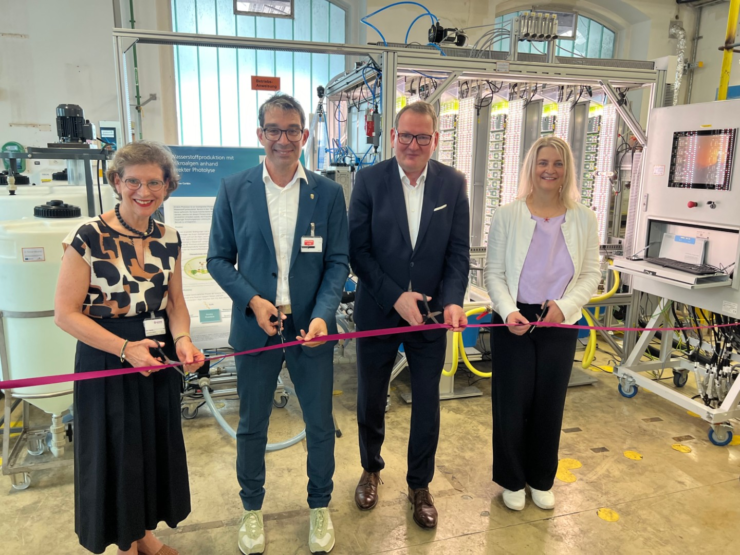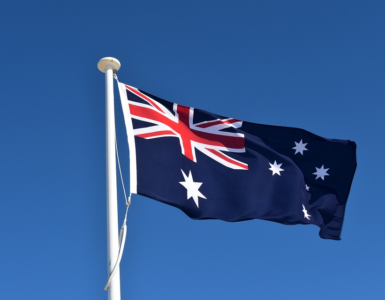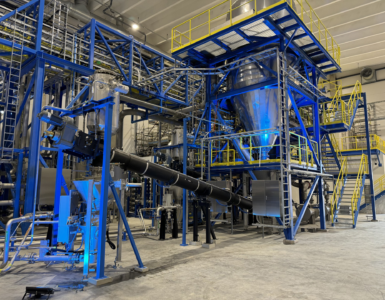A biorefinery for the circular economy of industrial waste streams – Green Hydrogen Production.
State Secretary for the Environment Dr. Andre Baumann opened the SmartBioH
2 -BW demonstration plant in Rheinfelden (Baden). The biorefinery was built at Evonik’s industrial site as part of the project coordinated by the Fraunhofer Institute for Interfacial Engineering and Biotechnology IGB. It uses rinse water and residual materials generated during production to produce “green” hydrogen and organic raw materials using two coupled biotechnological processes. Test operations are now starting under real conditions.
Waste and wastewater are a resource that has so far been little used worldwide. Baden-Württemberg wants to change this with the funding program “Bioeconomy – Biorefineries for the extraction of raw materials from waste and wastewater – Bio-Ab-Cycling”. Since October 2021, the Ministry for the Environment, Climate and Energy Sector of Baden-Württemberg has been using state funds and funds from the European Regional Development Fund (ERDF) to support the construction of modular biorefineries in order to test how high-quality raw materials can be recovered from waste and wastewater using sustainable bioeconomy.
One of the supported demonstration plants is the biorefinery of the SmartBioH 2 -BW project, which was inaugurated on August 3, 2024 by Dr. Andre Baumann, State Secretary in the Ministry of the Environment, as part of his summer tour. Numerous politicians from Rheinfelden, the district of Lörrach and some members of the state parliament also took the opportunity to visit the plant.
Dr. Baumann, State Secretary, said:
We urgently need a social change – away from the use of fossil or scarce resources and towards the use of bio-based or recycled materials. The SmartBioH 2 -BW project is an exemplary example of what such a forward-looking path can look like.
“Here, processes that already work individually on a small scale are combined and tested in demonstration and pilot plants. This is an important intermediate stage so that the processes can be used in the next step in municipalities or in industry. By using these biorefineries, we are ultimately not only protecting the climate and our resources, but also strengthening the resilience of Baden-Württemberg as a business location in crisis situations.”
The plant has been on the premises of Evonik in Rheinfelden for a few weeks now. Evonik Industries AG is one of the world’s largest manufacturers of specialty chemicals. At its site in southern Baden, Evonik produces, among other things, hydrogen peroxide, which is used as a disinfectant – for yogurt cups, for example. This, as well as other production processes in the plant, requires hydrogen, which the company has been producing on site from natural gas for decades.
Hermann Becker, site manager at Evonik, said:
The Evonik site in Rheinfelden has made it its mission to drive the green transformation of our industry.
“With the joint research project and the pioneering pilot plant, we want to show how this can be done in the spirit of the circular economy – clean hydrogen obtained from rinse water and residual materials is a win-win-win situation for the environment, the chemical industry and science.”
Intelligently coupled biotechnology for the biorefinery
The biorefinery was designed, planned and built by the Fraunhofer Institute for Interfacial Engineering and Biotechnology IGB in Stuttgart. It consists of two coupled process modules for the biotechnological production of hydrogen: fermentative dark photosynthesis by purple bacteria and a two-stage process with microalgae.
Dr.-Ing. Ursula Schließmann, deputy director of the Fraunhofer IGB and coordinator of the project, said:
By intelligently combining these two processes into a combined biorefinery concept.
“It will be possible to use industrial solid and liquid waste streams that arise in production at the site and previously had to be disposed of expensively as waste and wastewater efficiently and without emissions as raw materials in order to produce the future energy source hydrogen and other value-added bio-based products,”
The first step was to investigate the exact composition of the site’s waste streams and whether the organisms can actually cope with them. Liquid waste streams in Rheinfelden include rinse water, which is used to clean the production facilities. They contain a lot of ethanol, an alcohol. “It is conceivable that rinse water contains other substances that have a toxic or inhibitory effect on the bacteria and microalgae,”
The processes were therefore first tested separately at the Fraunhofer IGB under laboratory conditions with Evonik’s waste streams and then scaled up to a larger scale.
“Our analyses have shown that the rinse water contains not only ethanol but also other alcohols and residues of the synthesized products. However, these do not affect the growth of the purple bacteria or the microalgae,”
In July 2024, the two bioprocess modules were transported to the plant in Rheinfelden and put into operation. Now that the process units are coupled together, demonstration operations can begin under real conditions.
Hydrogen production with dark fermentation of purple bacteria
In the first stage of the biorefinery, the purple bacterium Rhodospirillum rubrum is used, which can produce hydrogen from various carbon substrates even without light using dark photosynthesis, a new type of fermentation. In Rheinfelden, the purple bacteria use ethanol from the rinse water as a carbon substrate and energy source.
To ensure sufficient growth and the synthesis of hydrogen, the composition of the fermentation medium had to be adjusted, as had already been shown in the laboratory in Stuttgart. The bacteria then produce not only the coveted hydrogen, but also other usable products such as carotenoids, fat-soluble pigments for cosmetics, for example, or the bioplastic polyhydroxyalkanoate (PHA) – as well as carbon dioxide (CO 2 ) as a byproduct.
Dr.-Ing. Susanne Zibek, Head of Bioprocess Development at Fraunhofer IGB, said:
Since the hydrogen-producing enzymes of the purple bacteria are very sensitive to oxygen, precisely controlling the oxygen content during fermentation is a challenge in operation.
Microalgae bind byproduct CO 2
In order to avoid the emission of CO 2 into the atmosphere, CO 2 is fed into the microalgae plant connected for this purpose in a further step. This is because the photosynthetically growing microalgae require CO 2 to build up biomass or storage products – just like green plants – and only light and nutrients.
In the SmartBioH 2 demonstration plant, microalgae of the species Chlorella sorokiniana are cultivated in a compact photobioreactor illuminated by LEDs. The reactor is characterized by a high degree of automation and offers a lot of volume in a small area. The process is operated in such a way that the microalgae produce starch as a usable product from the resulting CO 2. The nutrients required come from a second waste stream in Rheinfelden, this time in solid form: ammonium chloride.
Microalgae are also able to produce hydrogen under certain conditions. They use light energy to split water into hydrogen and oxygen.
Dr. Ulrike Schmid-Staiger, head of algae biotechnology at the IGB, said:
In order to use the process technically, the oxygen produced must be continuously removed from the system, as it inhibits the hydrogen production of the algae cells.
“A completely new type of photobioreactor that was developed for this purpose will be integrated into the biorefinery in a few weeks to further increase the overall yield of biohydrogen,” says the expert.
Process model for evaluation
The Fraunhofer Institute for Manufacturing Engineering and Automation is participating in the project by creating a process model that can predict the most important inputs and outputs of the entire biorefinery concept. The model also forms the basis for the ecological and economic evaluation of the biorefinery.
Edgar Gamero Fajardo from Fraunhofer IPA, said:
In this way, potential for improvement can be identified and the development of the technologies used can be controlled.
“Based on practical experience, we can then determine whether a plant on an industrial scale would also be economically viable. It is important that we have planned for a high degree of automation in order to improve the plant’s yield,” says Schließmann. But the saved disposal and transport costs also contribute to the overall balance.
Funding the project
The project “SmartBioH 2 -BW – Biohydrogen from industrial wastewater and residue streams as a platform for versatile biosynthesis pathways” is funded from October 2021 to October 2024 by the Ministry for the Environment, Climate and Energy Sector of Baden-Württemberg as part of the ERDF program “Bioeconomy – Biorefineries for the extraction of raw materials from waste and wastewater – Bio-Ab-Cycling”.
READ the latest news shaping the hydrogen market at Hydrogen Central
A biorefinery for the circular economy of industrial waste streams – Green Hydrogen Production. source









